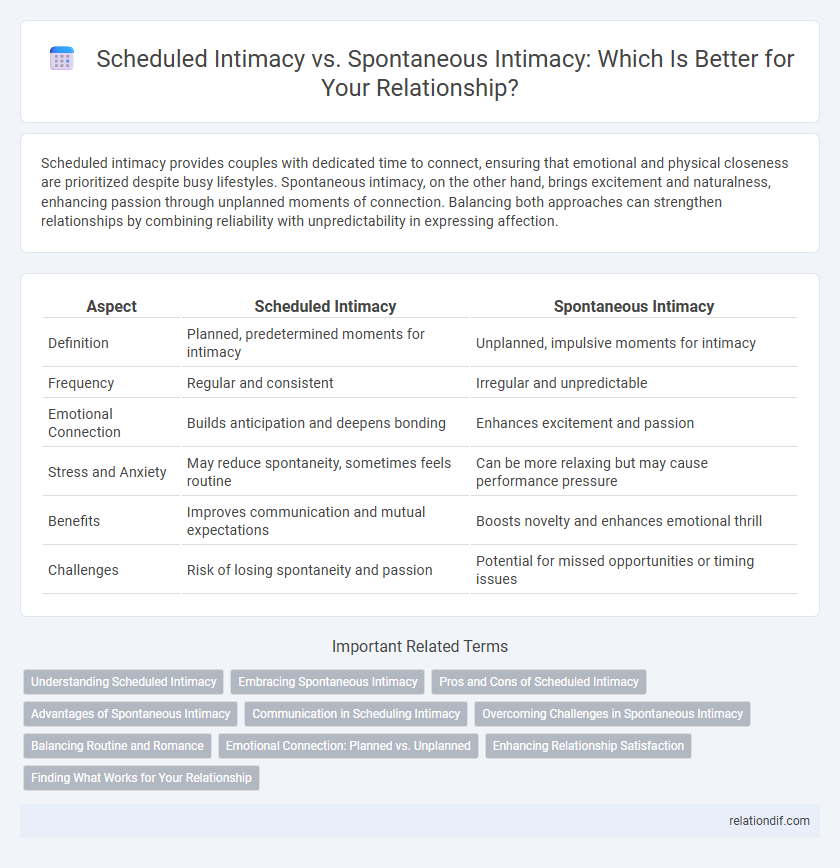Scheduled intimacy provides couples with dedicated time to connect, ensuring that emotional and physical closeness are prioritized despite busy lifestyles. Spontaneous intimacy, on the other hand, brings excitement and naturalness, enhancing passion through unplanned moments of connection. Balancing both approaches can strengthen relationships by combining reliability with unpredictability in expressing affection.
Table of Comparison
| Aspect | Scheduled Intimacy | Spontaneous Intimacy |
|---|---|---|
| Definition | Planned, predetermined moments for intimacy | Unplanned, impulsive moments for intimacy |
| Frequency | Regular and consistent | Irregular and unpredictable |
| Emotional Connection | Builds anticipation and deepens bonding | Enhances excitement and passion |
| Stress and Anxiety | May reduce spontaneity, sometimes feels routine | Can be more relaxing but may cause performance pressure |
| Benefits | Improves communication and mutual expectations | Boosts novelty and enhances emotional thrill |
| Challenges | Risk of losing spontaneity and passion | Potential for missed opportunities or timing issues |
Understanding Scheduled Intimacy
Scheduled intimacy allows couples to prioritize physical connection amidst busy lifestyles, enhancing anticipation and emotional readiness. Research shows that setting specific times for intimacy can reduce stress and improve relationship satisfaction by fostering consistent bonding rituals. Understanding this approach helps partners communicate needs effectively and create a balanced dynamic between structure and passion.
Embracing Spontaneous Intimacy
Spontaneous intimacy fosters genuine emotional connection by allowing partners to respond naturally to moment-to-moment desires, enhancing feelings of closeness and excitement. Unlike scheduled intimacy, it reduces pressure and predictability, promoting a more authentic experience that can deepen trust and satisfaction. Embracing spontaneous moments cultivates creativity and attentiveness in relationships, strengthening bonds through unplanned expressions of affection.
Pros and Cons of Scheduled Intimacy
Scheduled intimacy ensures consistency, helping couples maintain a regular connection despite busy lifestyles, which can strengthen emotional bonds and improve relationship satisfaction. However, it may reduce spontaneity and excitement, potentially making intimacy feel routine or forced, which can diminish natural passion. Balancing scheduled intimacy with moments of unplanned connection is essential to sustain both reliability and emotional freshness in relationships.
Advantages of Spontaneous Intimacy
Spontaneous intimacy fosters deeper emotional connection by encouraging natural, unplanned moments of closeness that enhance relationship excitement and unpredictability. It often leads to heightened passion and bonding through genuine expressions of desire, making interactions feel more authentic and fulfilling. Romantic relationships benefit from this spontaneity as it stimulates attraction and reinforces intimacy without the pressure of rigid timing.
Communication in Scheduling Intimacy
Effective communication in scheduling intimacy ensures both partners' needs and desires are acknowledged, fostering emotional connection and reducing misunderstandings. Discussing preferences and boundaries openly allows the creation of mutually satisfying plans that respect individual rhythms. This proactive dialogue strengthens trust and enhances relationship satisfaction by balancing anticipation with genuine connection.
Overcoming Challenges in Spontaneous Intimacy
Spontaneous intimacy often faces challenges such as busy schedules, lack of privacy, and mental distractions that hinder authentic connection. Overcoming these obstacles requires mindfulness, effective communication, and creating a flexible mindset to embrace unplanned moments. Prioritizing emotional openness and reducing stress improves receptiveness, enabling deeper, more meaningful spontaneous experiences.
Balancing Routine and Romance
Scheduled intimacy ensures consistent connection by creating dedicated time for partners to engage emotionally and physically, addressing busy lifestyles and reducing relationship neglect. Spontaneous intimacy introduces excitement and unpredictability, fostering deeper attraction and emotional bonding through unplanned moments of affection. Balancing routine and romance enhances relationship satisfaction by combining reliability with novelty, meeting partners' needs for security and passion simultaneously.
Emotional Connection: Planned vs. Unplanned
Scheduled intimacy provides a dedicated space to nurture emotional connection through deliberate time and effort, fostering anticipation and consistent bonding. Spontaneous intimacy often sparks genuine emotional responses driven by in-the-moment feelings, enhancing authenticity and excitement in the relationship. Both approaches contribute uniquely to emotional closeness by balancing predictability with natural emotional expression.
Enhancing Relationship Satisfaction
Scheduled intimacy provides couples with dedicated time to connect, ensuring consistent emotional and physical closeness that strengthens relationship satisfaction. Spontaneous intimacy fosters excitement and novelty, enhancing emotional bonds through unexpected moments of affection and connection. Balancing both approaches allows partners to experience stability and passion, promoting sustained relationship fulfillment.
Finding What Works for Your Relationship
Scheduled intimacy ensures consistent connection and helps busy couples prioritize their relationship, fostering anticipation and emotional security. Spontaneous intimacy brings excitement and unpredictability, enhancing passion and deepening emotional bonds. Finding what works involves balancing routine with spontaneity to meet both partners' needs and strengthen overall relationship satisfaction.
Scheduled intimacy vs spontaneous intimacy Infographic

 relationdif.com
relationdif.com